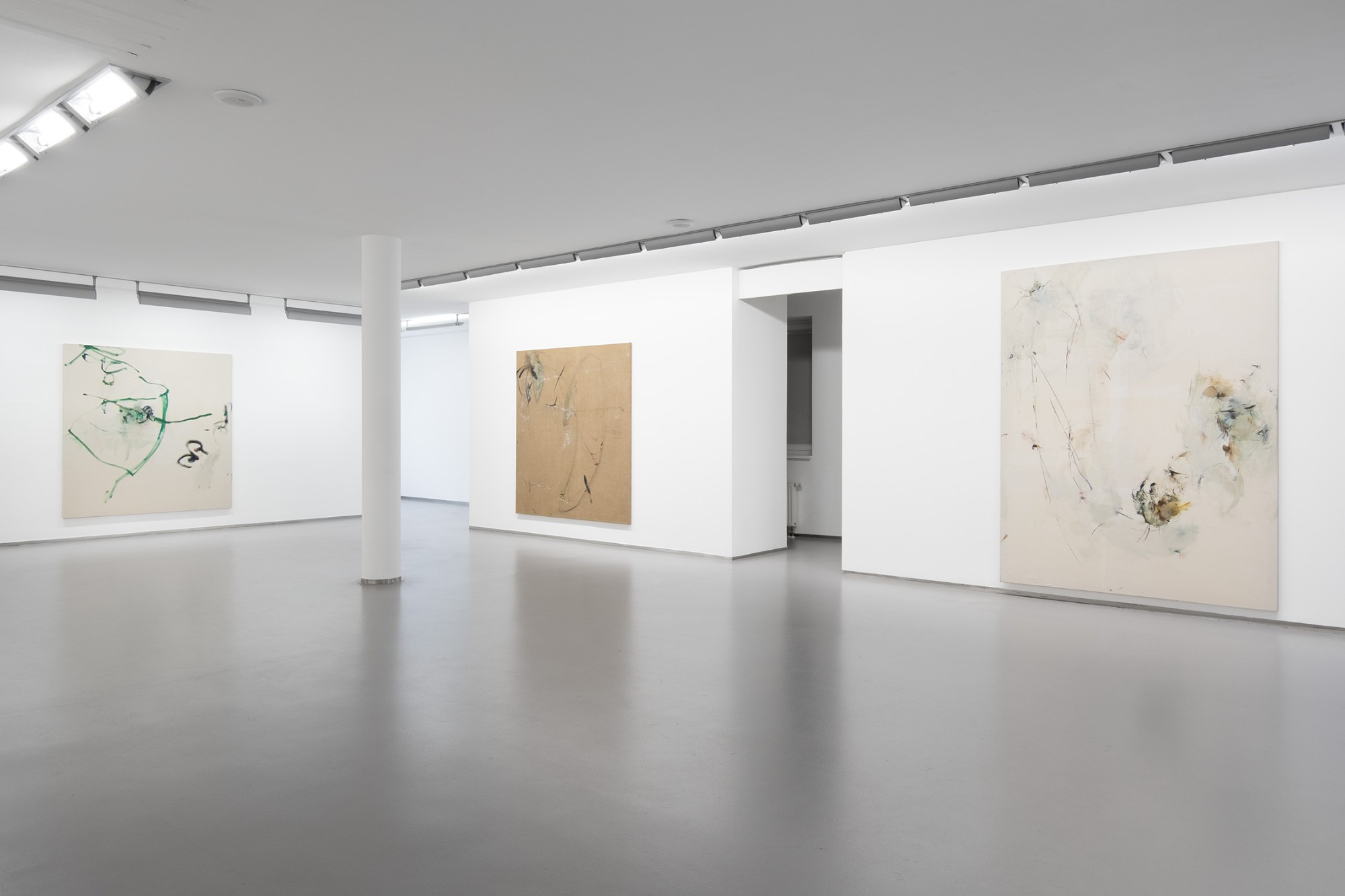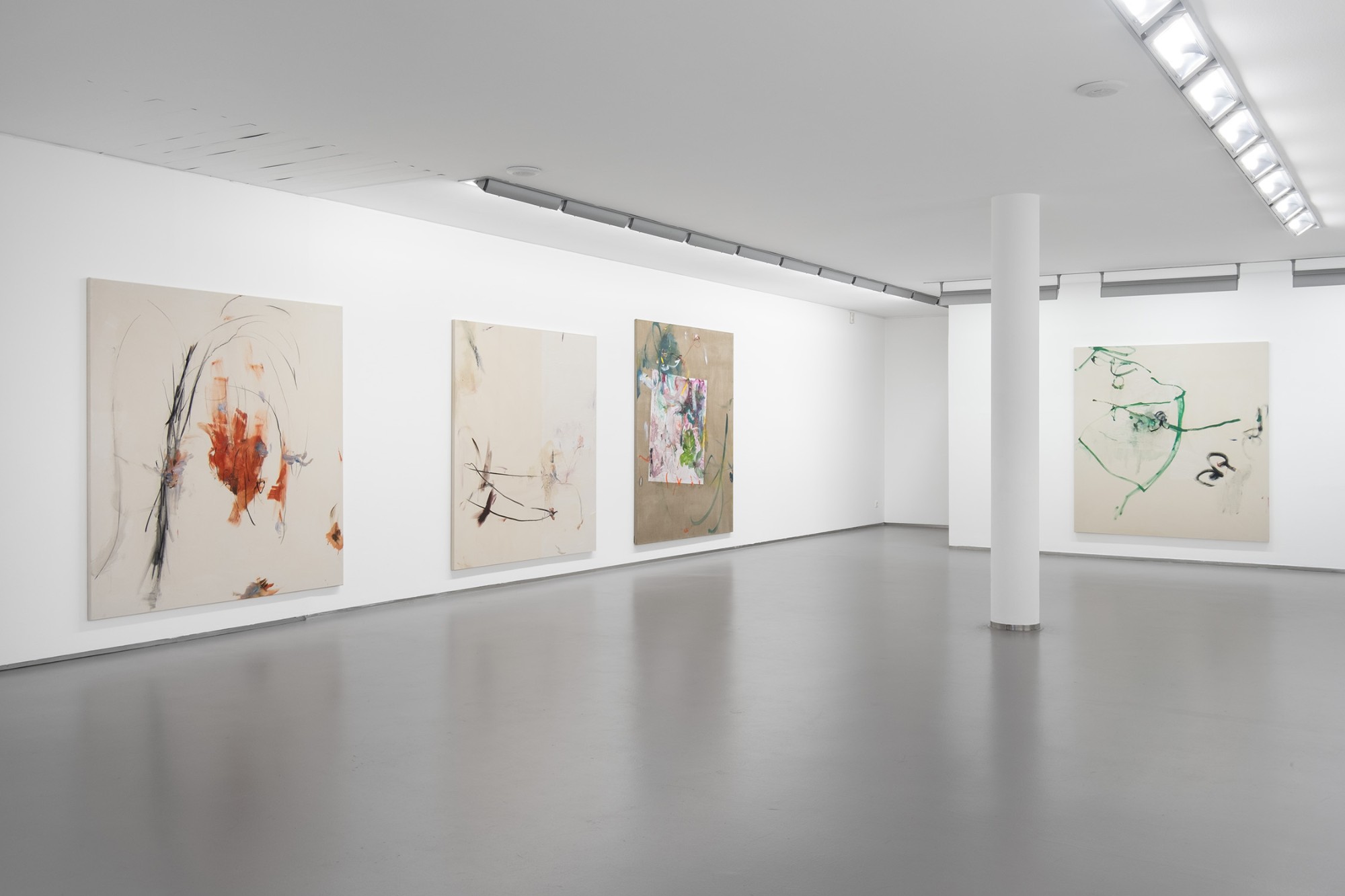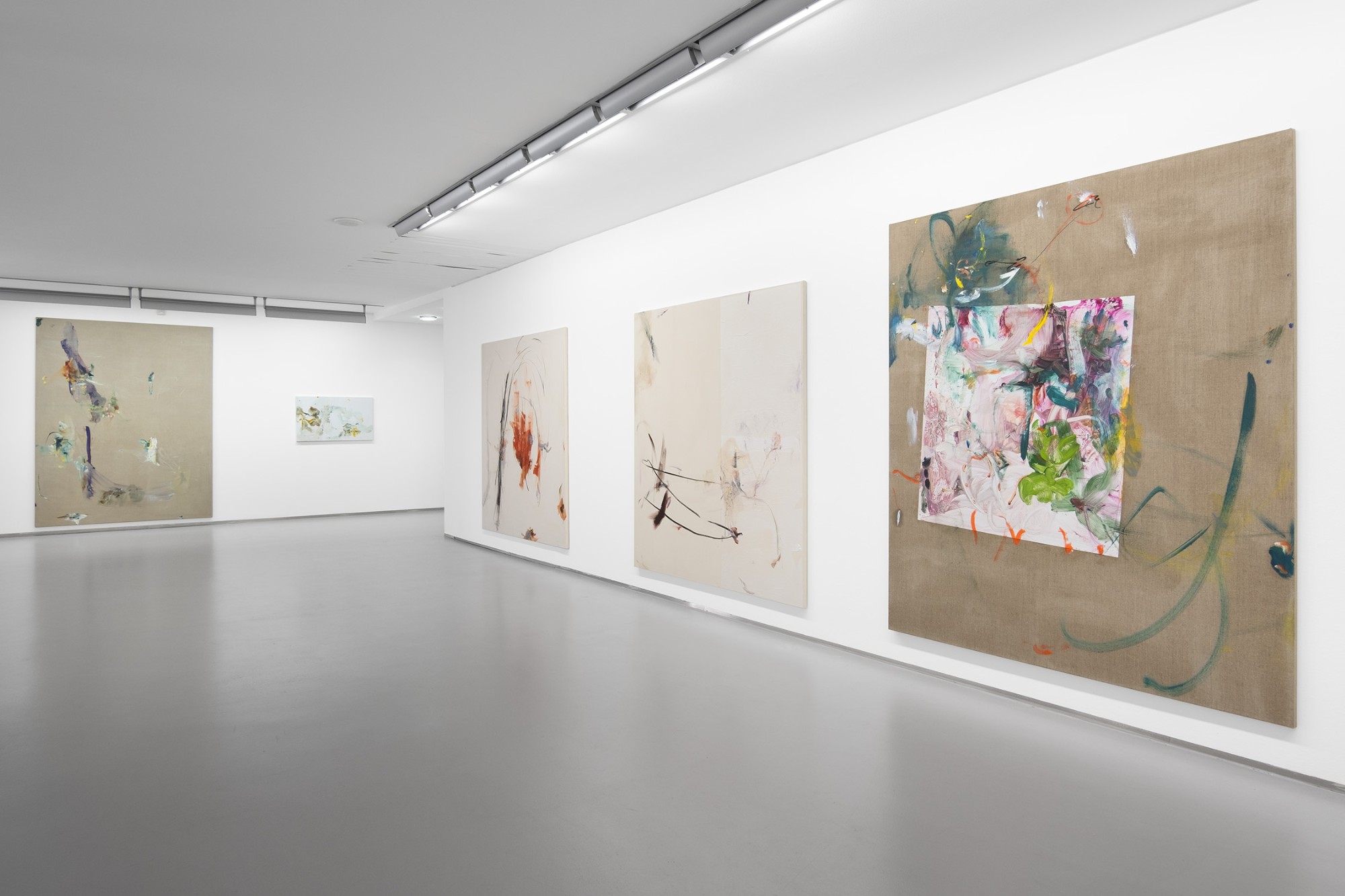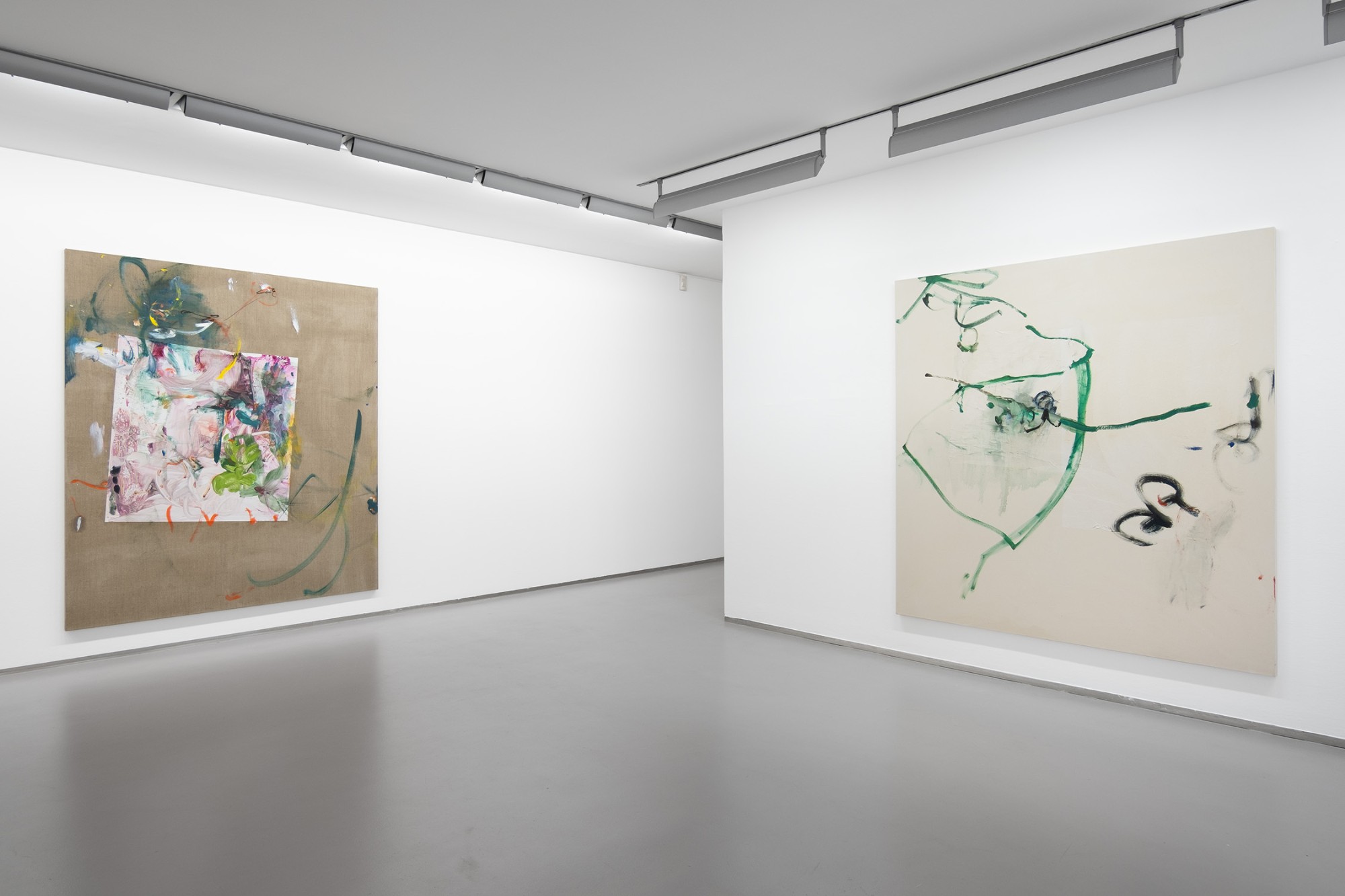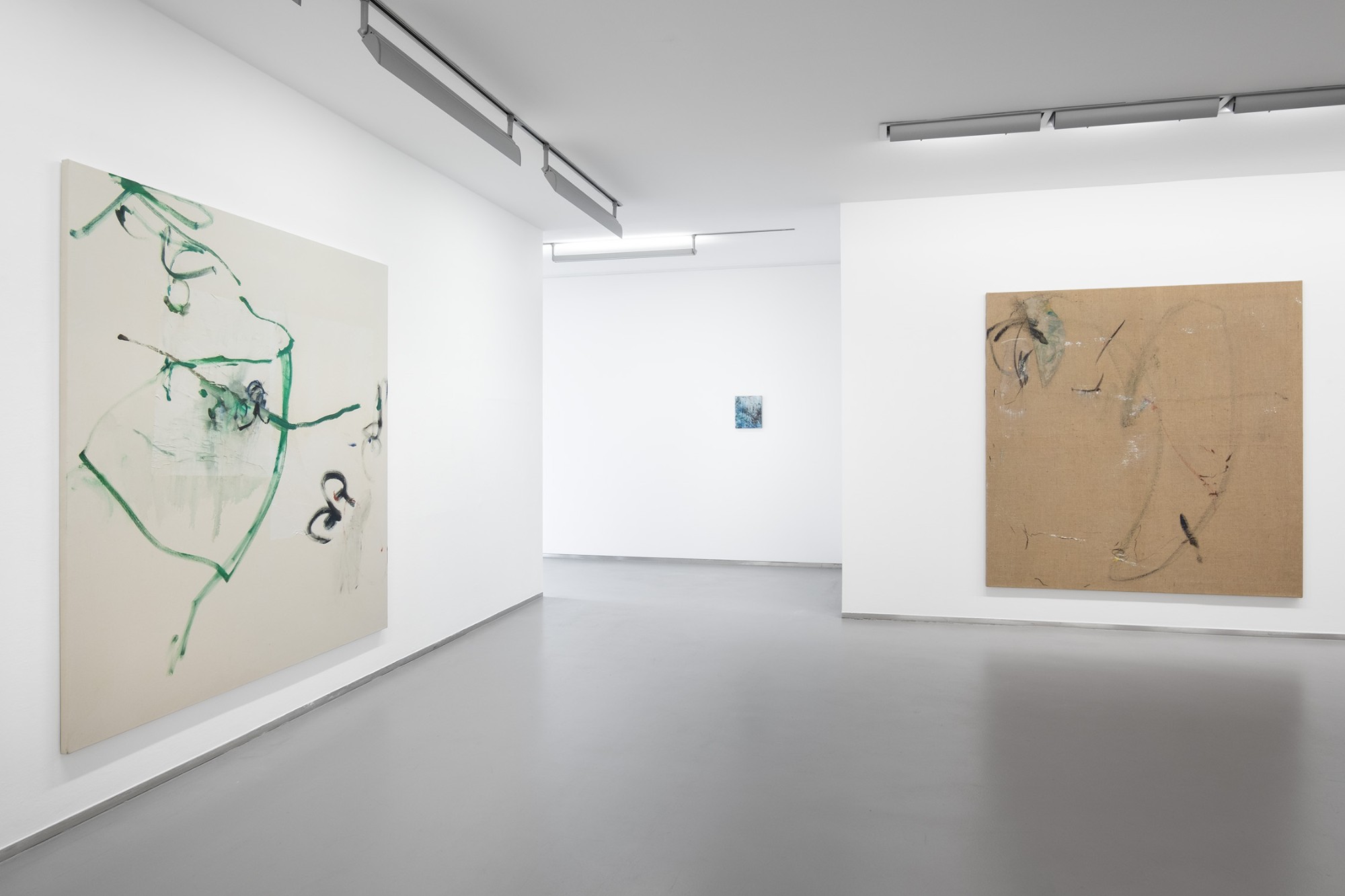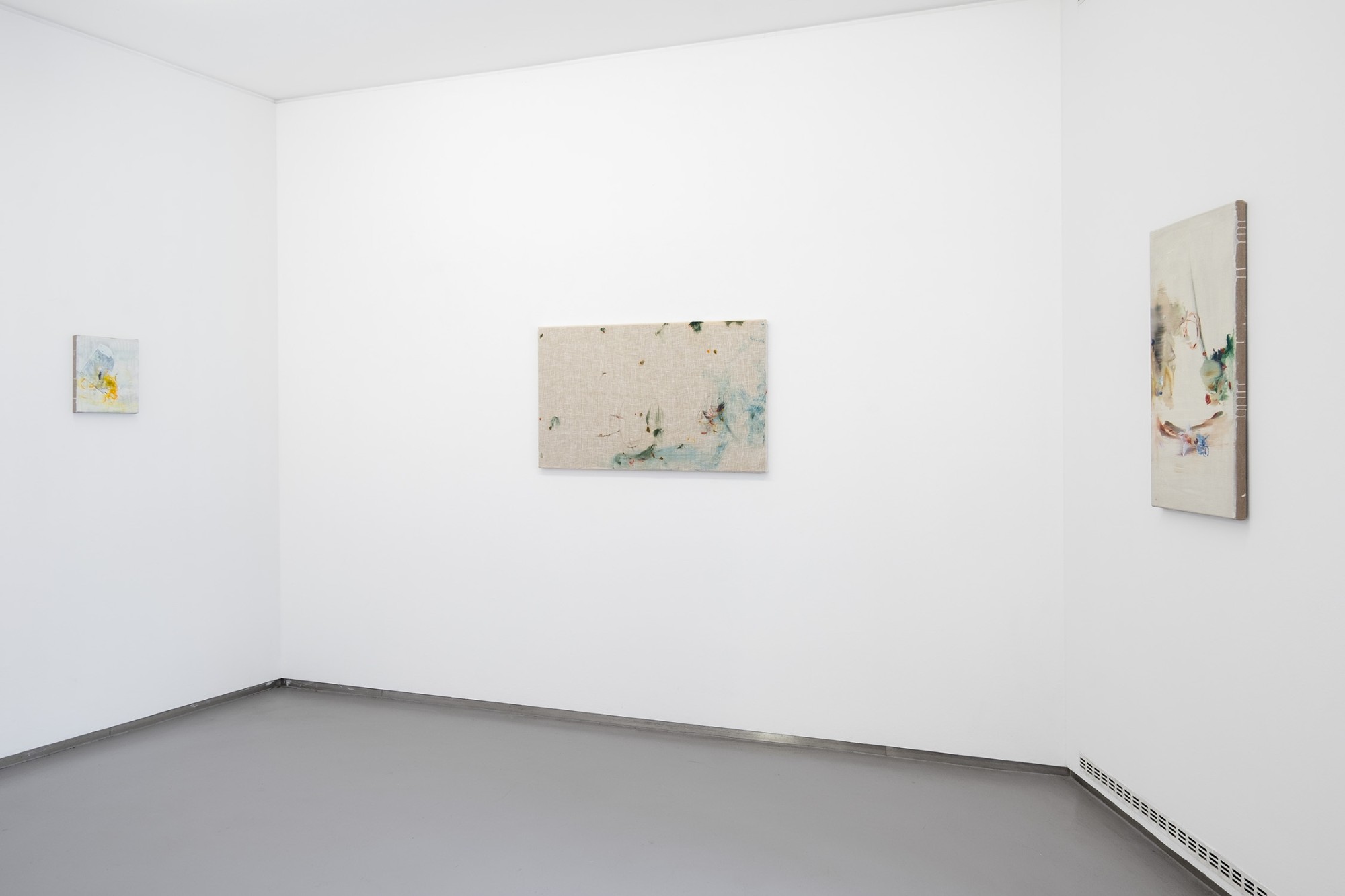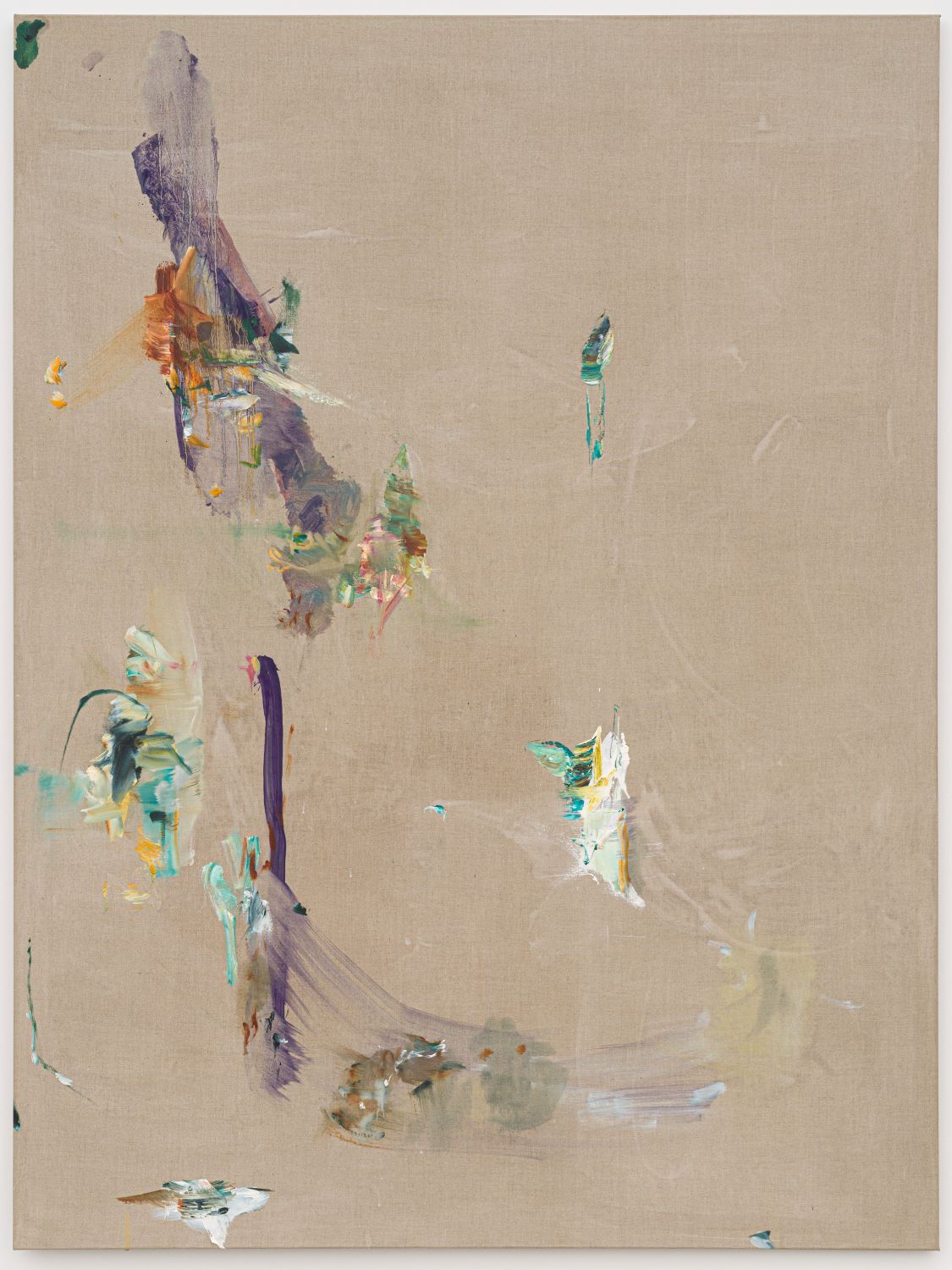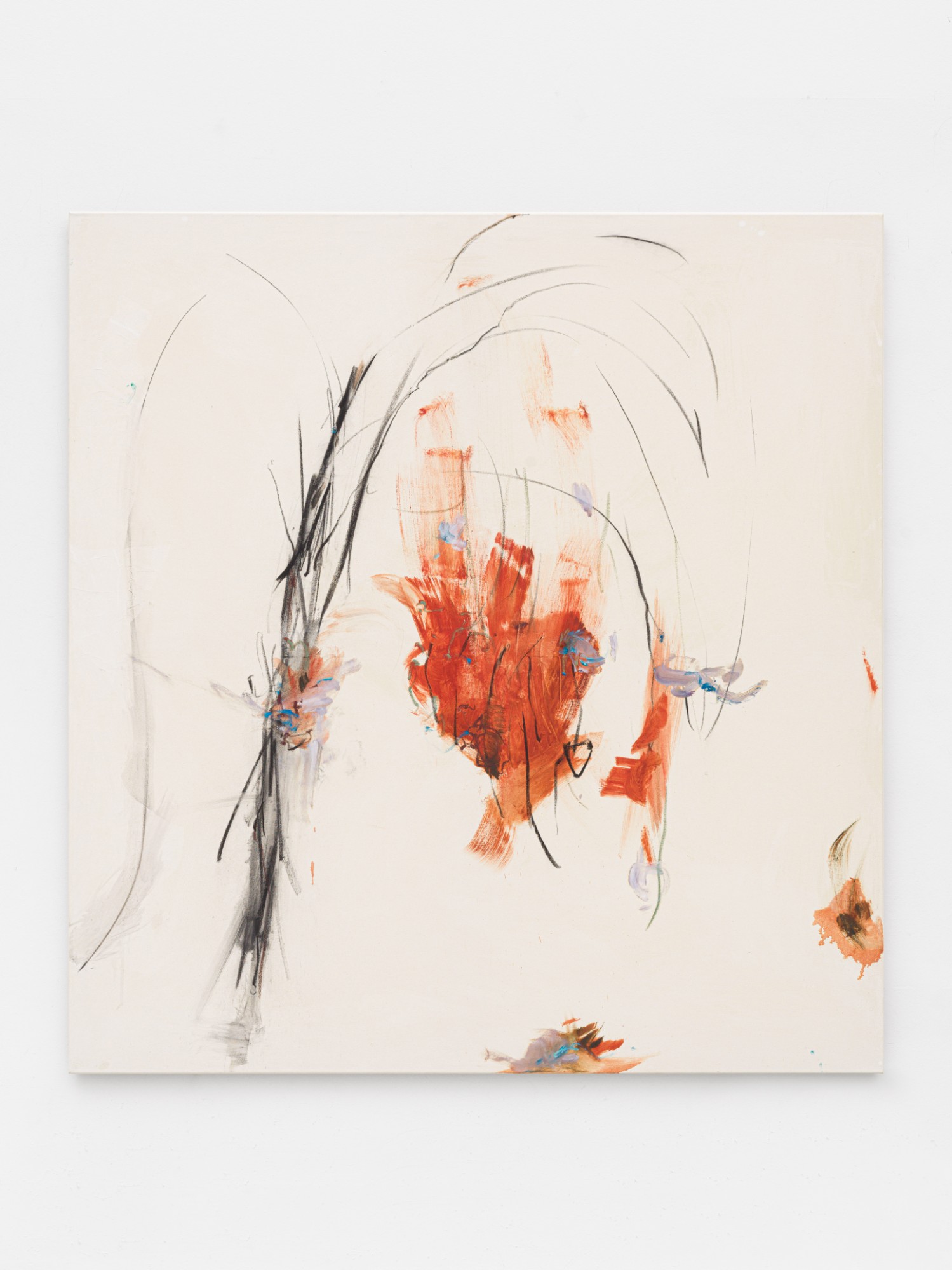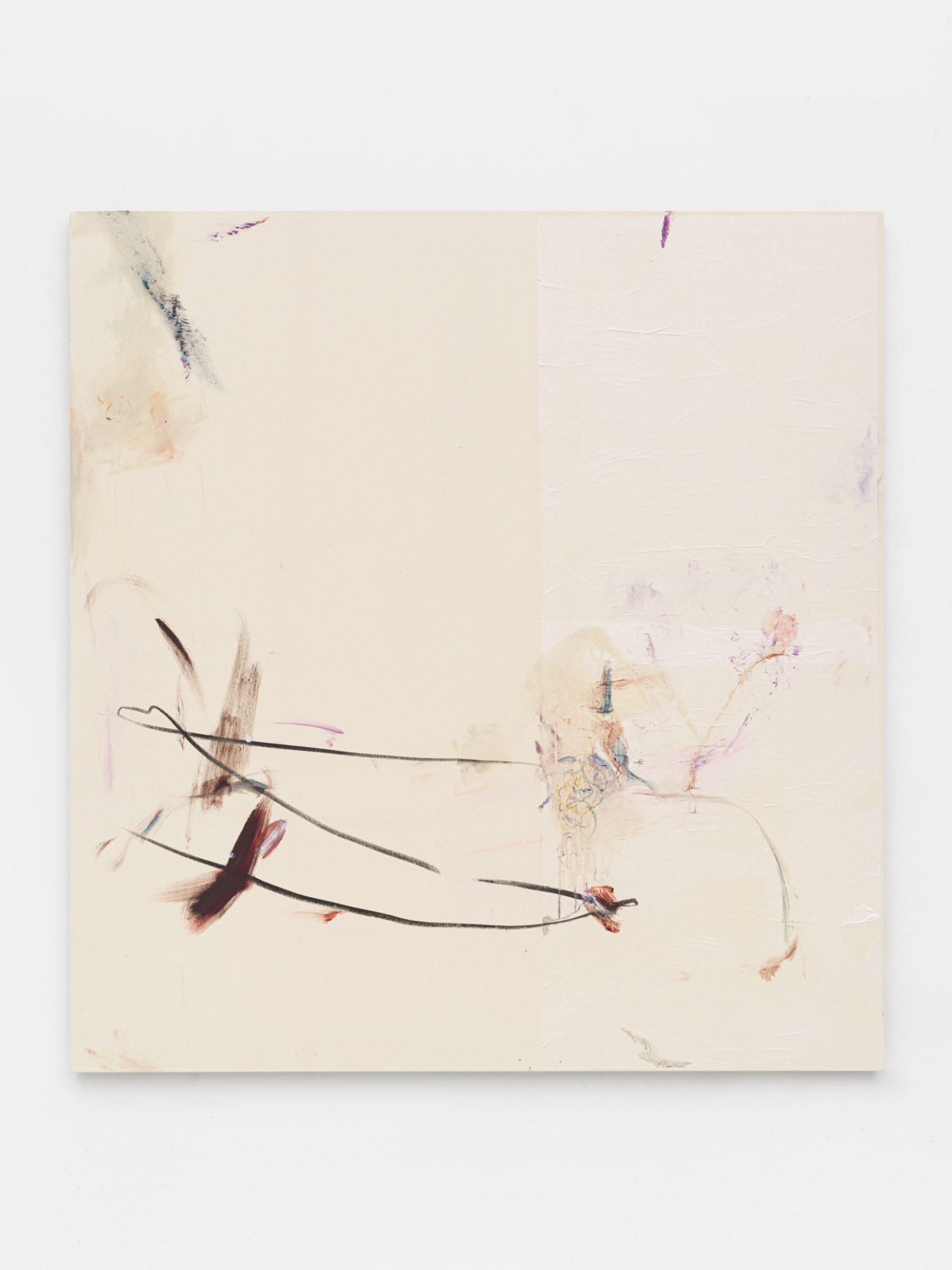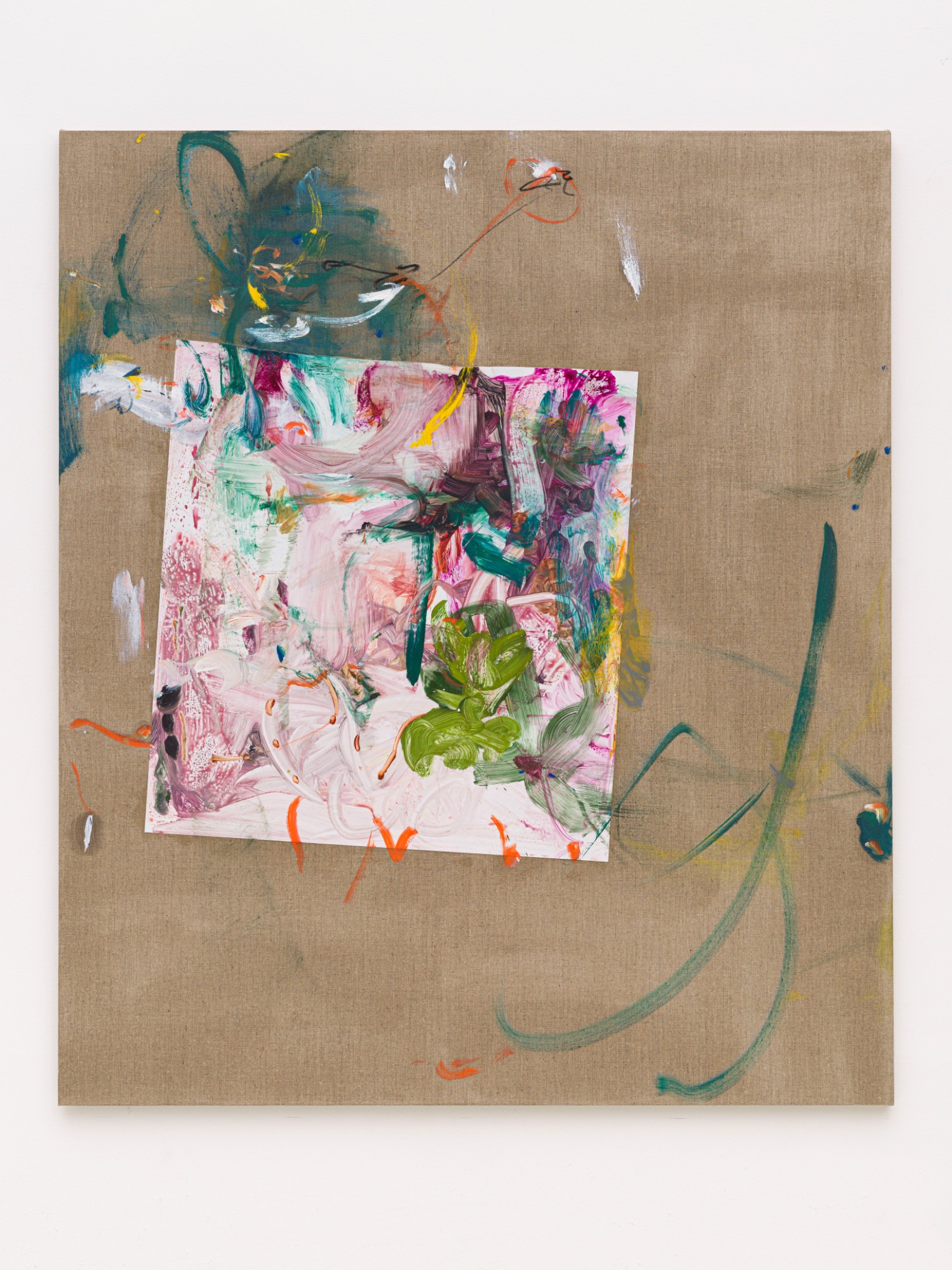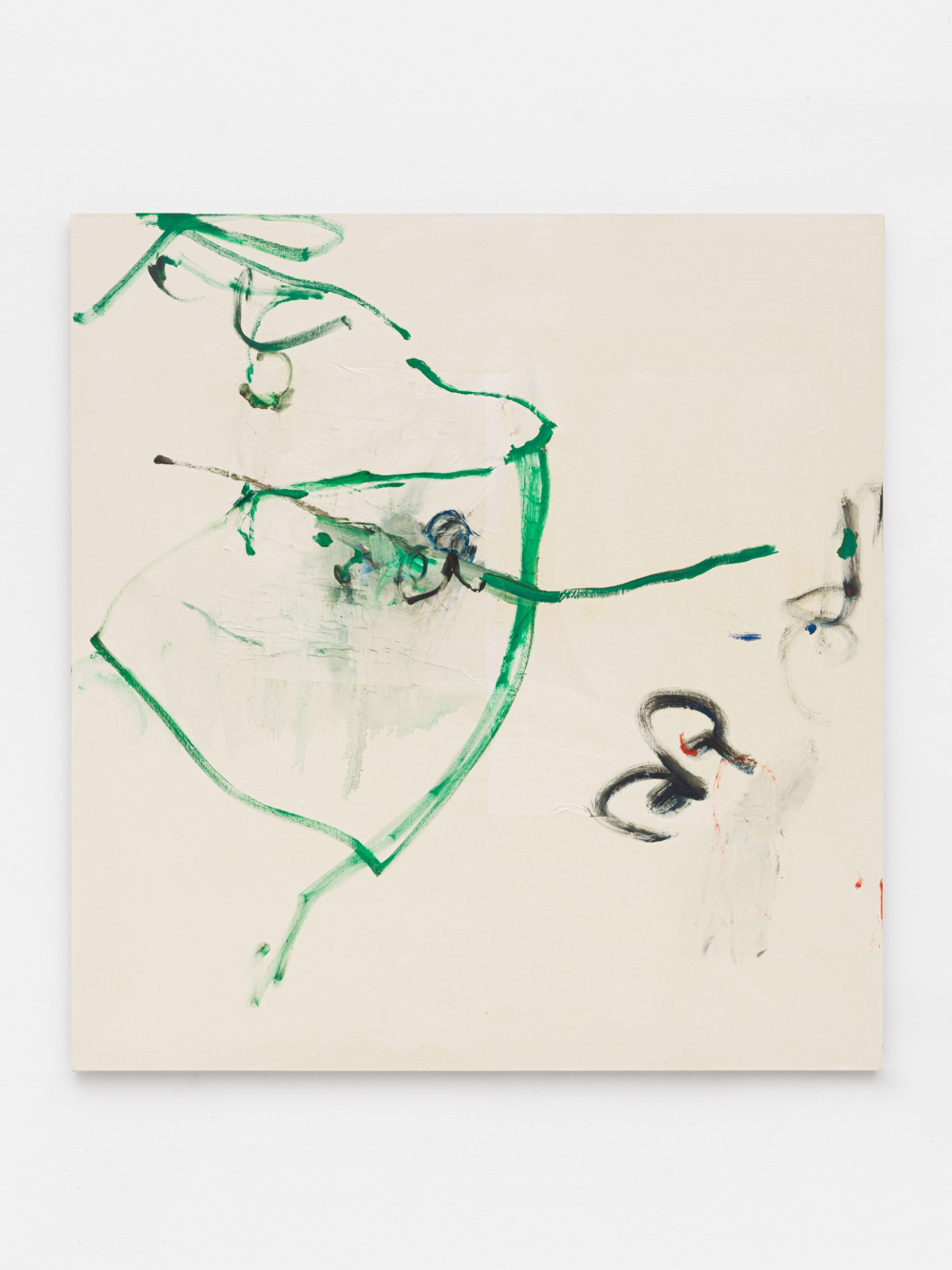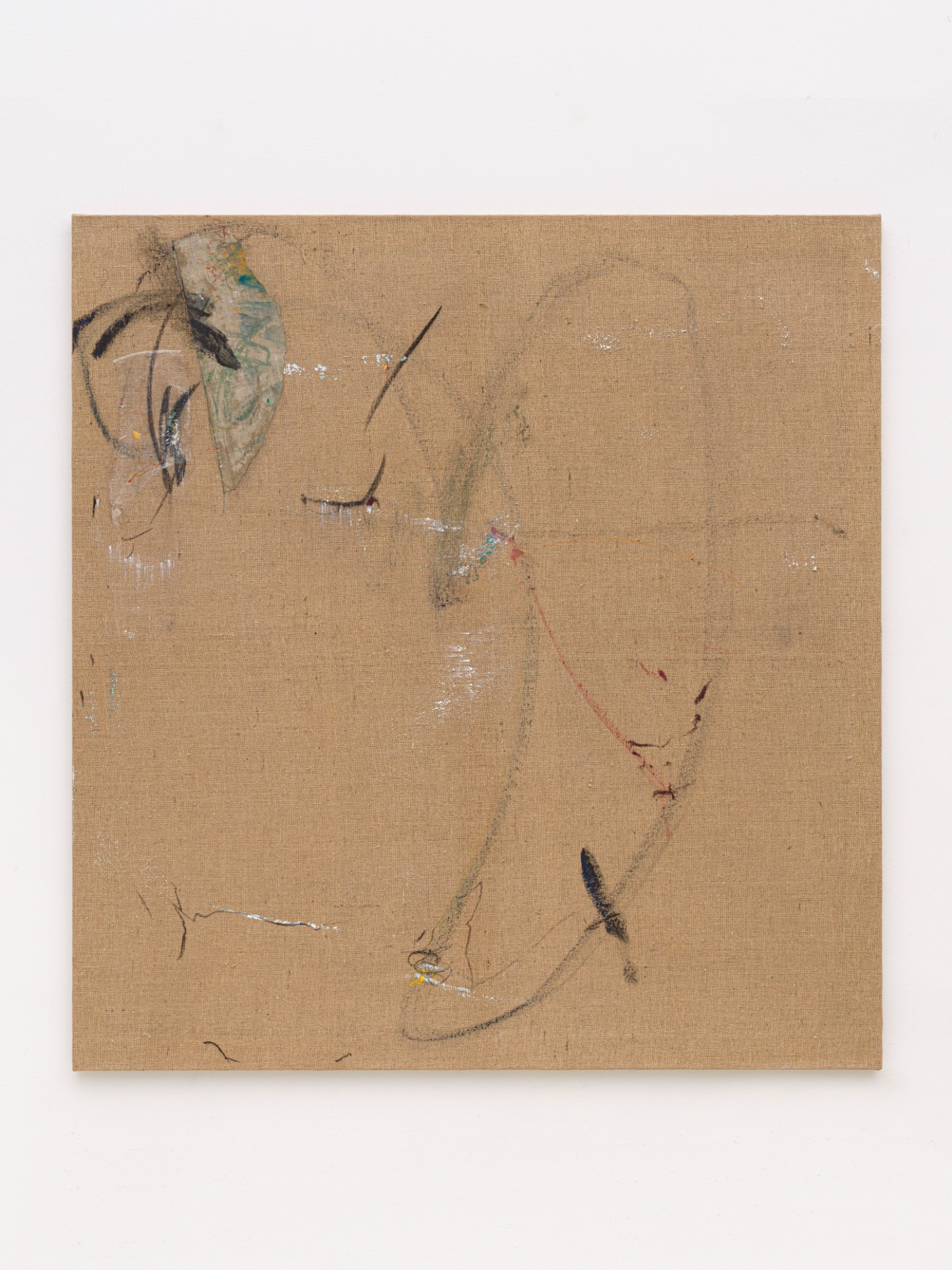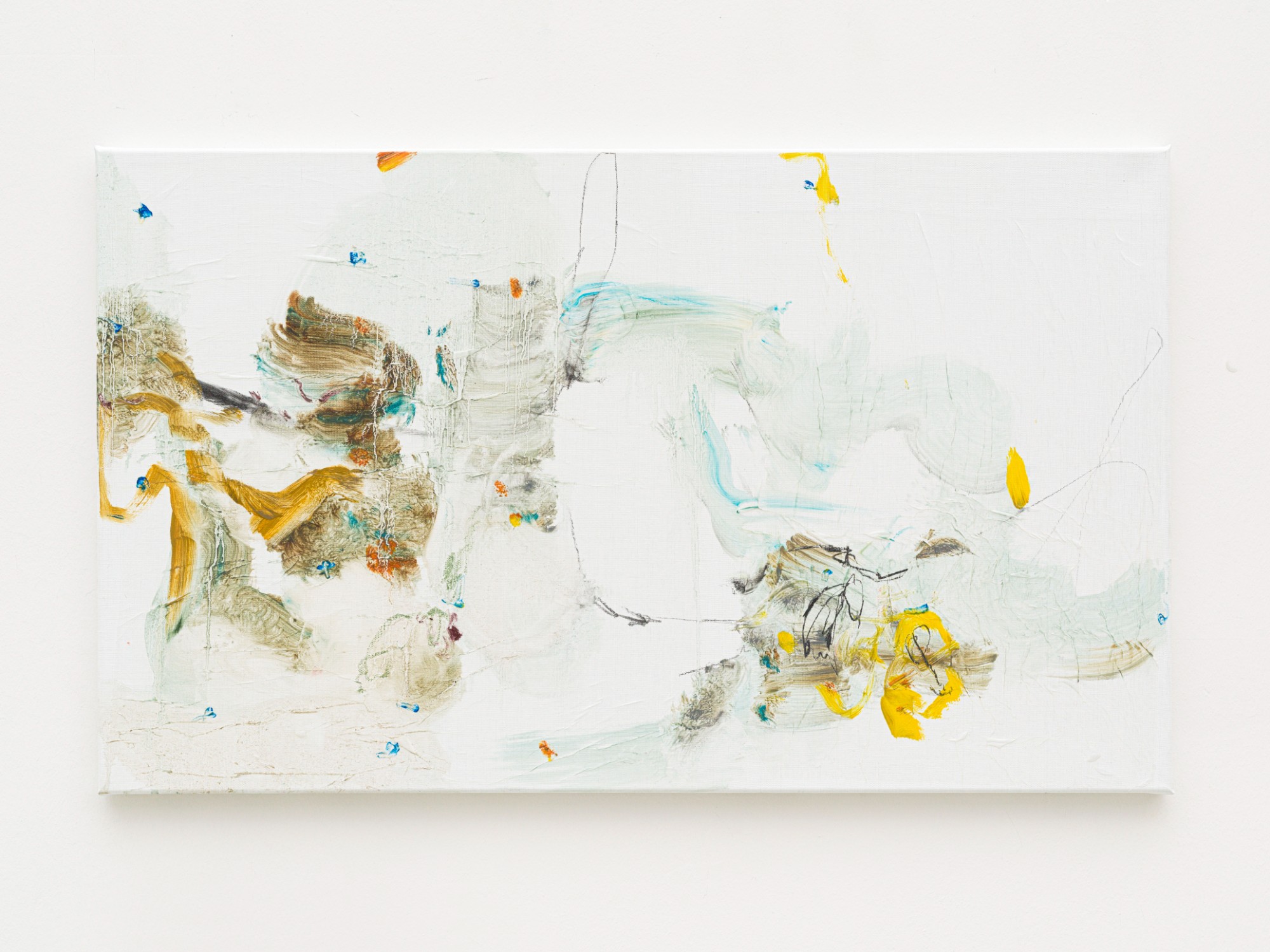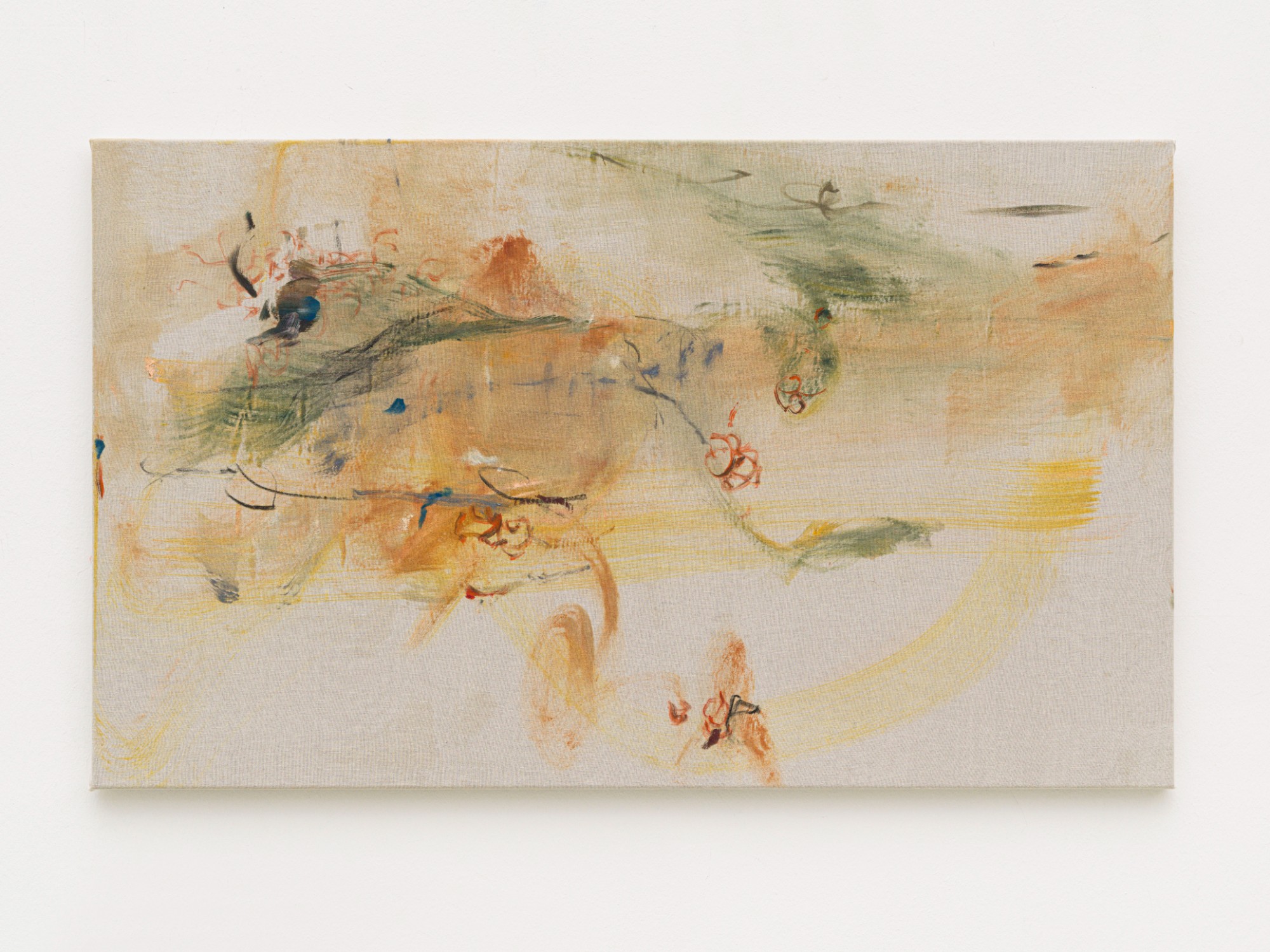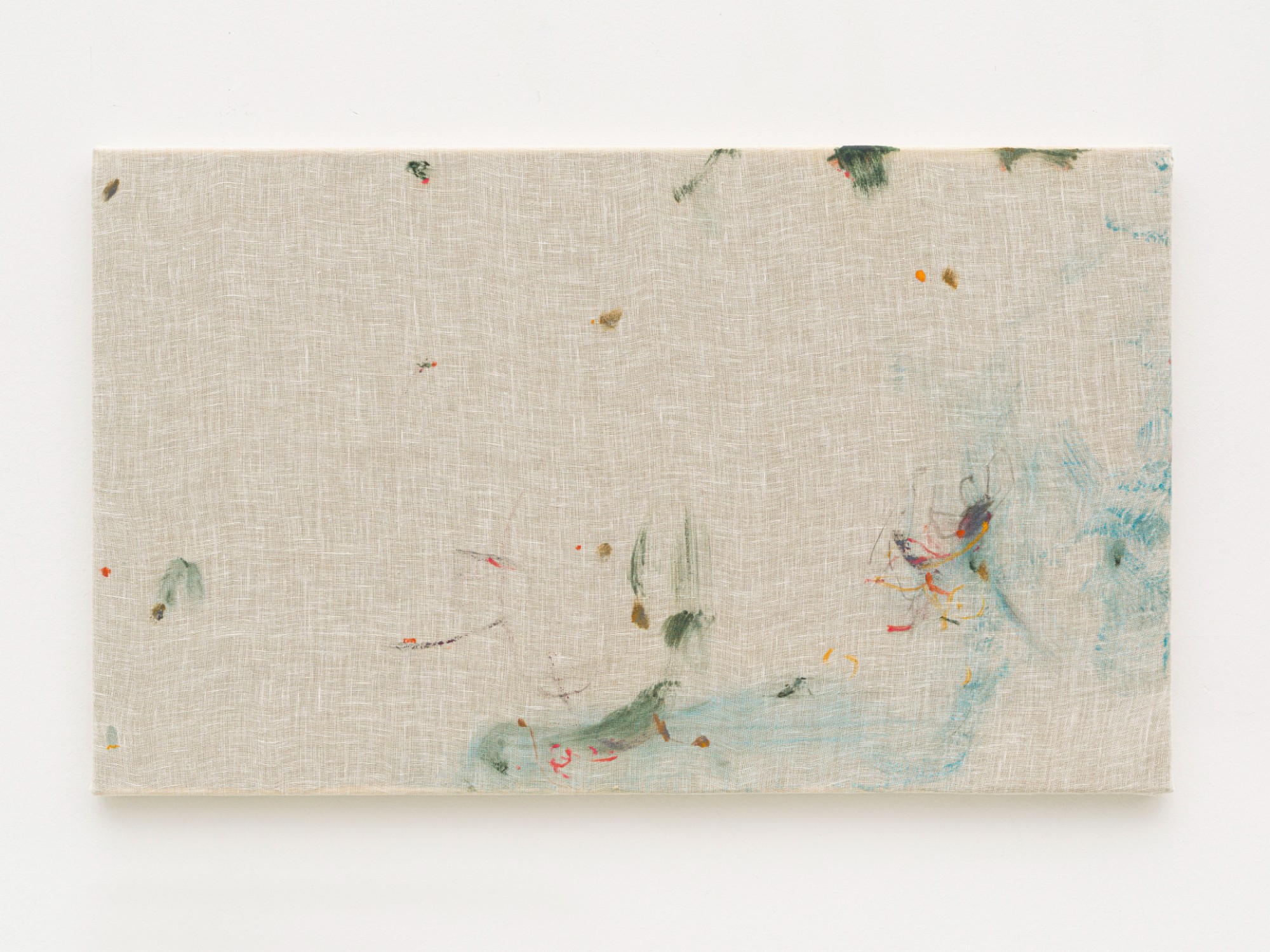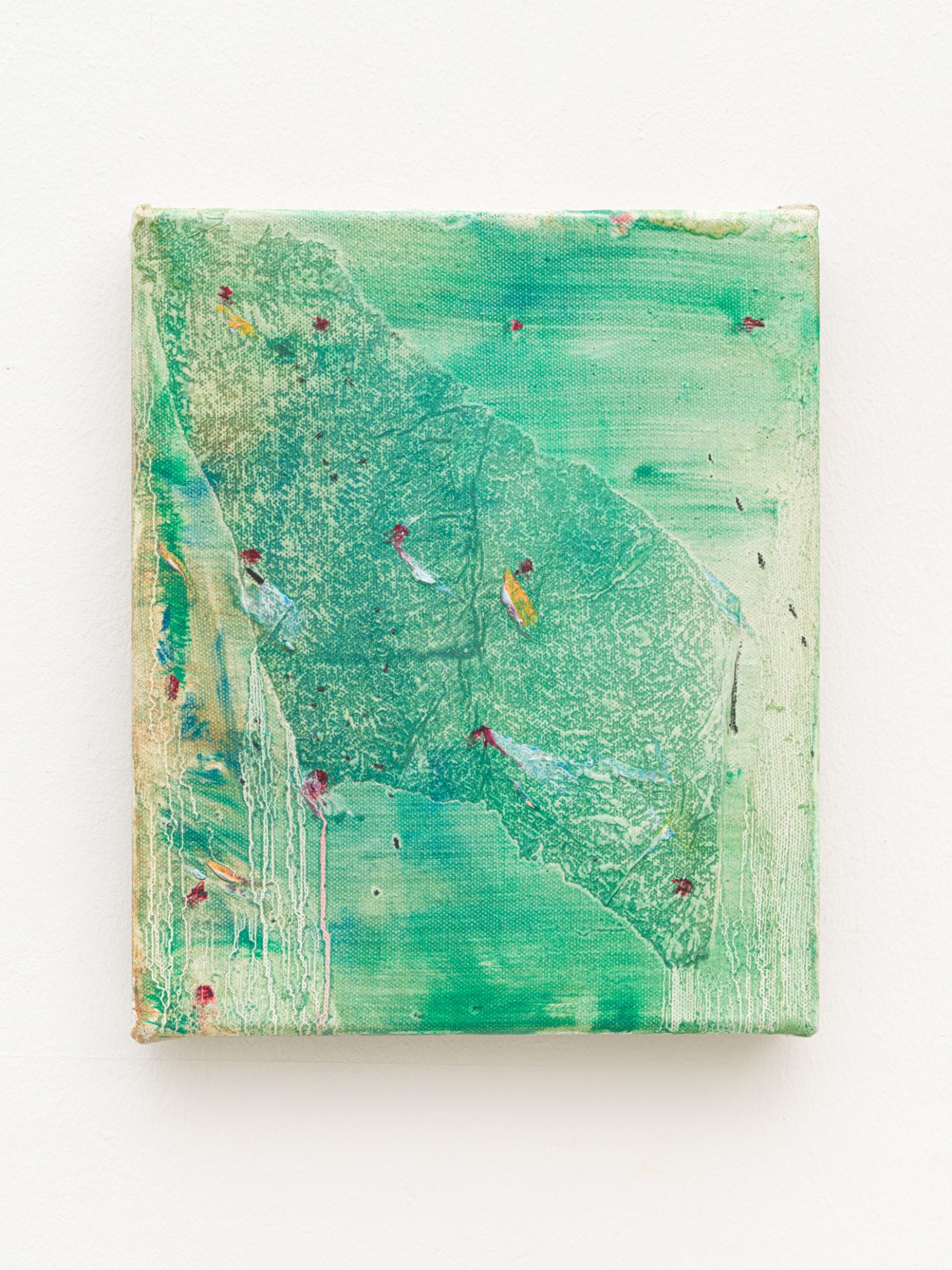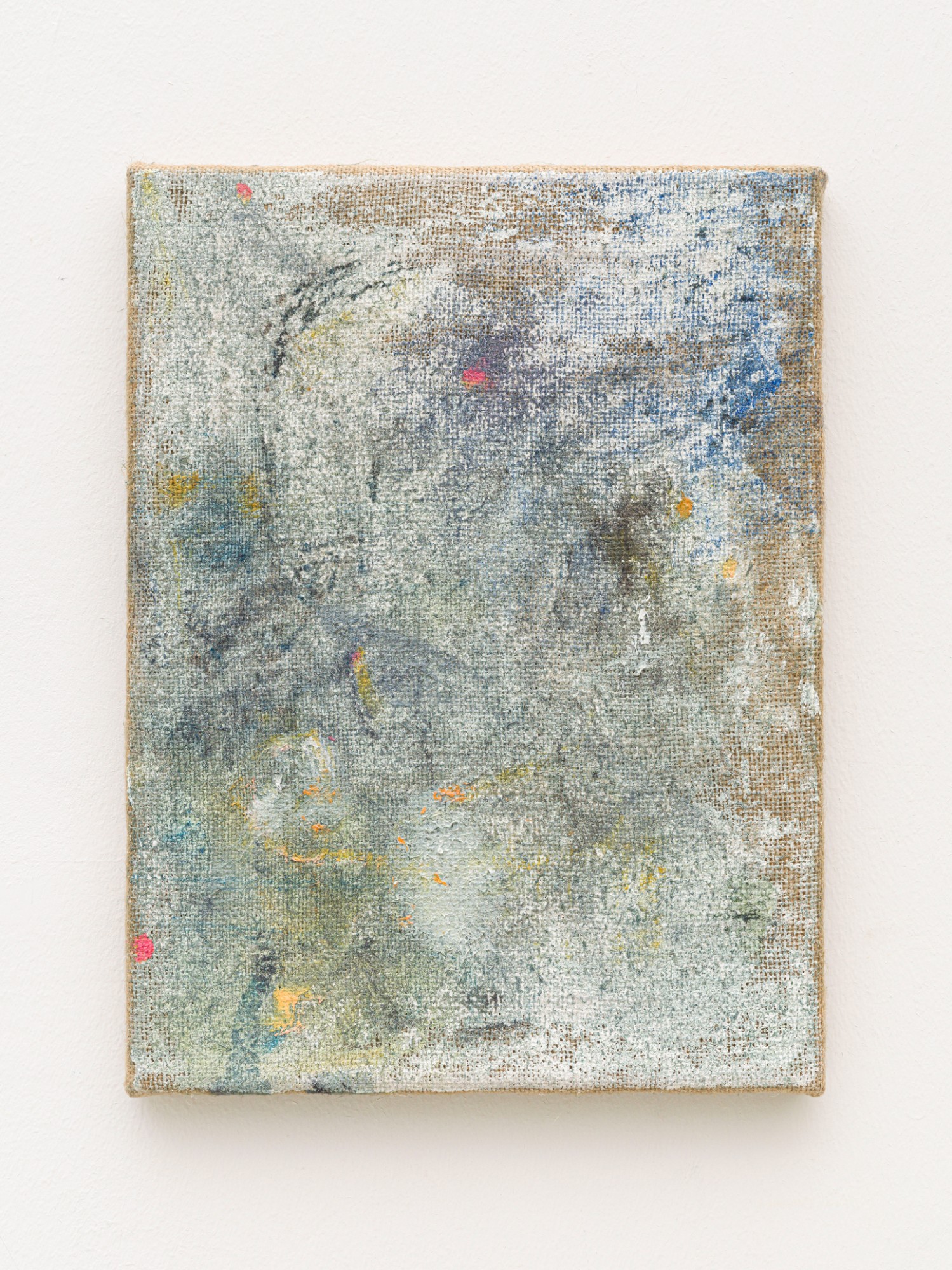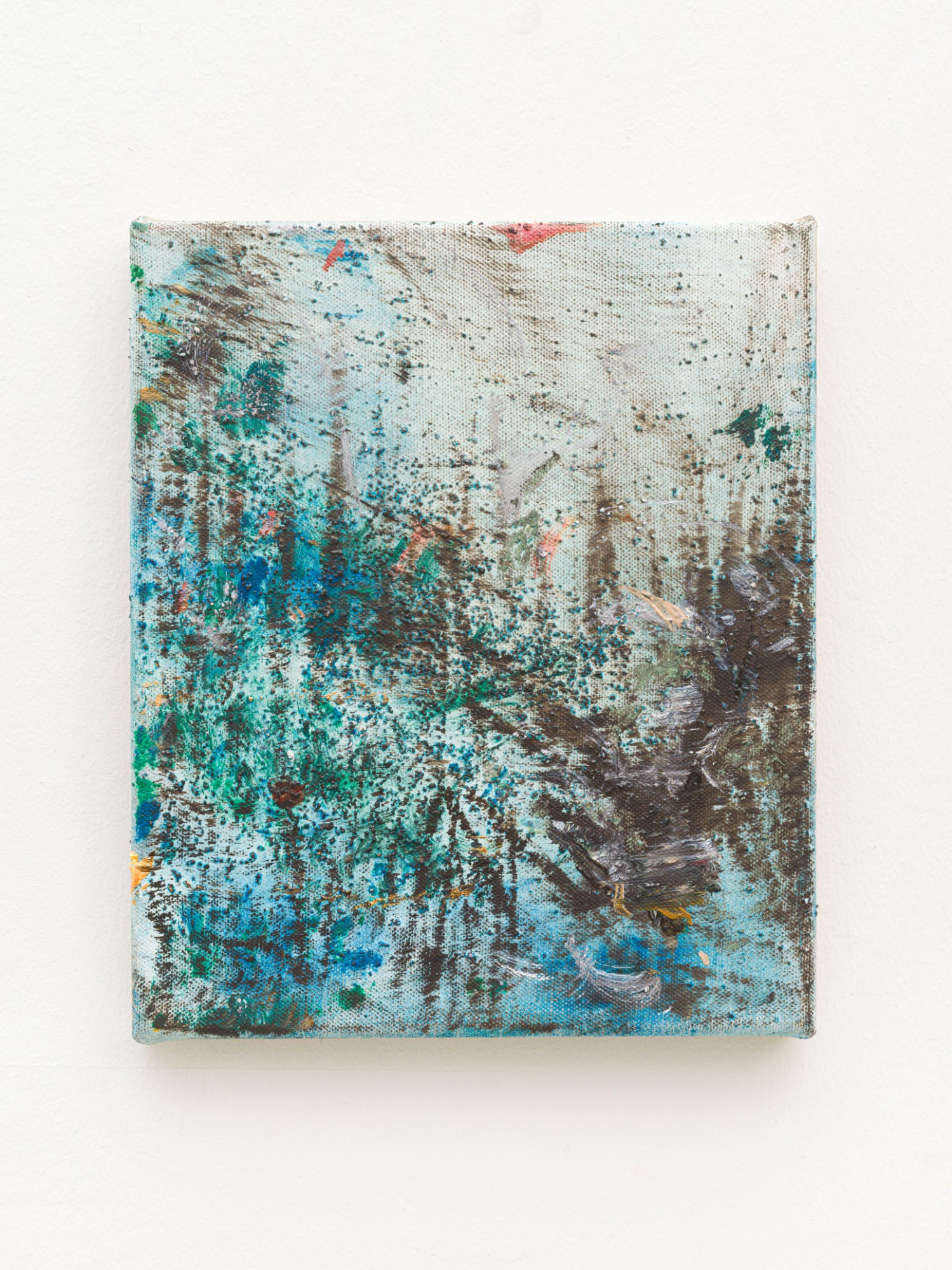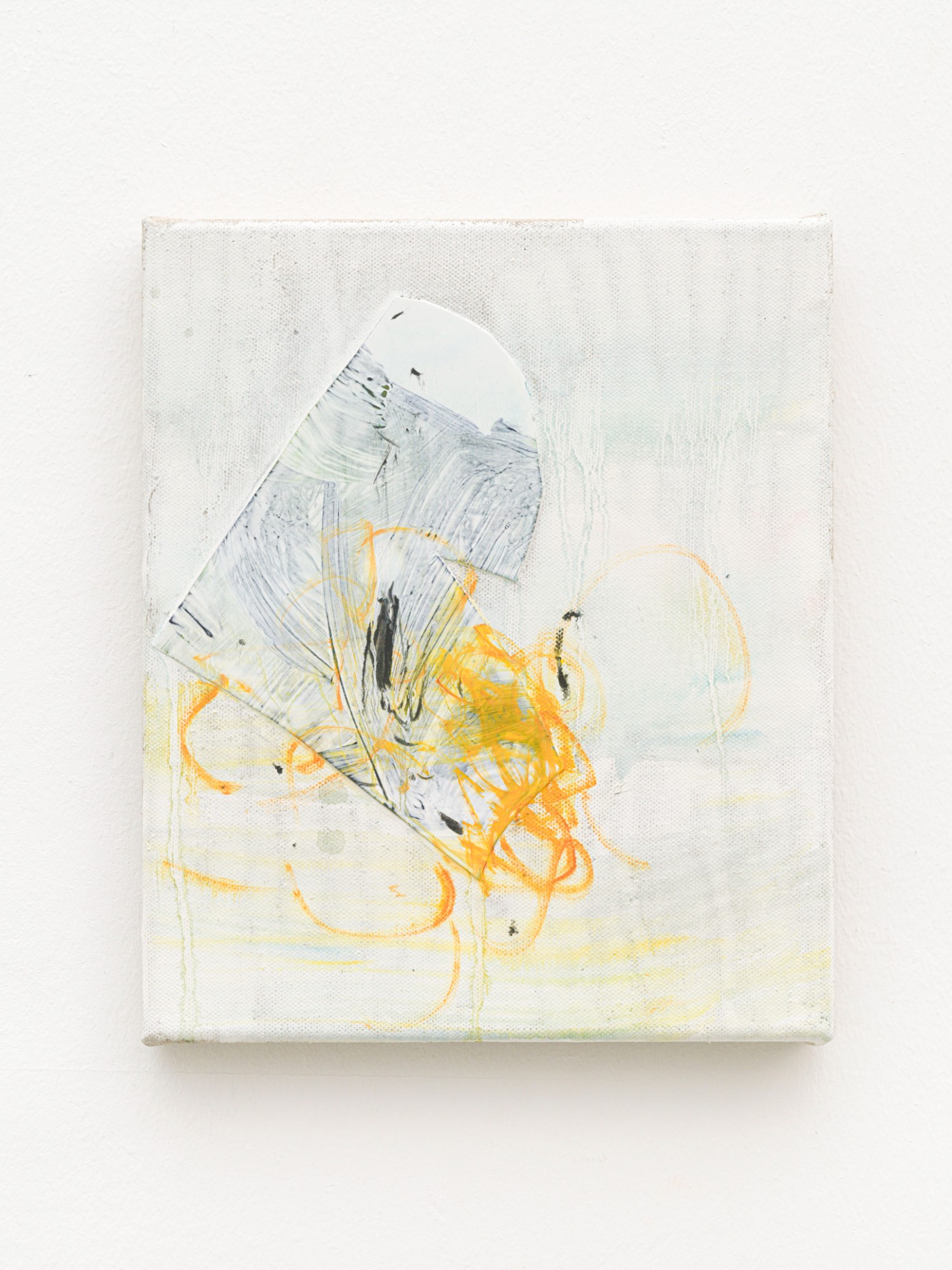Hinako Miyabayashi
Please scroll down for the German version
Press release
As I watched the steadily falling snow from my parents' house in Sapporo, I realized that the world is multi-faceted. The sight of the snow falling so far that it threatened to disappear from view gave me the stimulus for the picture I wanted to paint. There seemed to be neither a beginning nor an end, and yet each snowflake seemed to have its own unique time.
Words on paper, poems in hiragana, undecipherable characters in ancient Japanese paintings: No longer words, but landscapes.
Snow covers the park, splashes of color from the playground equipment are gleaming. Above me branches swaying in the wind. Buds, children's laughter, cars passing by, the gray sky, the color of the leaves, three trash cans.––They all pause, as if they were letters. A blue time. The branch that slips into my field of vision disappears from the landscape after one step.
That I am being drawn by the material, I perceive as a natural phenomenon.––To express or to cause this only by my own will and manual dexterity seems arrogant to me. Rather, it is the natural, incidental moment of wonder when I come across these momentary phenomena that constitutes the drawing.
- Hinako Miyabayashi
---
It is clear from Miyabayashi's words that she seeks to connect with the surroundings and objects she contemplates, expressing the subtle sensory nuances from deep within herself. This careful and intimate poetry of hers is also evident in her work titles, and her words and images seem inextricably linked. However, the core of her art is not concerned with poems, but with the impressive transformation of that lyrical sensation into painting. For her, what remains undescribed is painting.
The ancient Roman poet Horace is credited with the saying, "A poem is like a painting (Ut pictura poesis)." In China, on the other hand, there is an old proverb that states: "A poem is a painting with a voice, a painting is a poem without a voice."
In "Laokoon" (1766), Gotthold Lessing distinguished visual art from literature, drawing a clear line between poetry and painting. Clement Greenberg deepened this differentiation, focusing on material-specific form and establishing formalism as the theoretical foundation of modern art. In his writings, he also commented on Eastern art.
"Actually, not one of the original "abstract expressionists" -least of all Kline- has felt more than a cursory interest in Oriental art. The sources of their art lie entirely in the West; what resemblances to Oriental modes may be found in it are an effect of convergence at the most, and of accident at the least." ("American-Type" Painting / Clement Greenberg, 1955).
Maybe that's the way it is. Does Asian art not fit the "form" he established?
In China, in ancient times, the art of writing was as highly regarded as poetry and painting. The cornerstones of fine arts are "writing and painting", true to the idea of "the symbiosis of poem, writing and painting". This notion is based on the idea that poems and painting are inextricably linked. In their origins, writing and painting used the same brush, ink, and paper, and came from a shared source. It was not uncommon for paintings to include poetry. The distinct aesthetic sensibility for Chinese poems, writing and painting arrived in Japan alongside profound Buddhist thought.
Handwriting is poetry and visual art at the same time. In the most fundamental sense, there is no demarcation between the two. They represent meaning, matter, physicality, shape, sound, fragment, abstraction, relationships, vacancy, and they are borderless. Thus, writing is in a perpetual state of form-finding, since it cannot yet be reduced to a primordial form. This is also the case with Miyabayashi's painting.
The writing system "Hiragana" preferred by Miyabayashi was created in the 9th century by simplifying the Kanji which originated in China (Chinese script) and is only used in Japan. Hiragana (feminine handwriting), in contrast to the formal Kanji (masculine script), was used mainly in private letters and notes. Many kanji originated as ideograms, with each kanji having its own meaning. Hiragana, on the other hand, are a reduction, distortion, or fragment of kanji that represents only its sound and has no independent meaning. It is a sound that is created from the form.
Amidst the continuously falling snow, Miyabayashi recognizes the multi-faceted nature of the world. She senses fragments of many different eras, although right now the snow is filling the field of vision and transforming the world into a uniform white.
Miyabayashi's artwork is not focused on form, not on materiality or even action. It is not about depictions, meanings, appearances, representations, symbols, signs, or immersion. It is about "presence." It is an emotional ambush. It is more connected with "approach" than with a reality. It is made up of subtle elements that overlap and line up like sounds, tactile sensations, echoes, and light reflections.
It is the perception of the present. The little something that is transforming just before our eyes assails us. In that moment when we approach the world, we come into contact with the perception that is in front of us. In this sense, Miyabayashi's paintings are, beyond specific boundaries, open to all.
- Nobuhiko Murayama
Pressetext
Als ich vom Haus meiner Eltern in Sapporo den stetig fallenden Schnee beobachtete, wurde mir bewusst, dass die Welt sehr vielschichtig ist. Der Anblick des Schnees, der so weit fiel, dass er aus dem Blickfeld zu verschwinden drohte, gab mir den Anstoß für das Bild, welches ich malen wollte. Es schien weder einen Anfang noch ein Ende zu geben und doch schien jede Schneeflocke ihre eigene, eindeutige Zeit zu haben.
Worte auf Papier, Gedichte in Hiragana, unlesbare Schriftzeichen in alten japanischen Bildern: Nicht mehr Worte, sondern Landschaften.
Schnee bedeckt den Park, Farbtupfer der Spielgeräte blitzen auf, über mir im Wind schwingende Zweige, Knospen, Kinderlachen, vorüberziehende Autos, der graue Himmel, die Farbe der Blätter, drei Abfalleimer - sie alle verharren, gleichsam wie Buchstaben. Eine blaue Zeit. Der Ast, der in mein Blickfeld rutscht, verschwindet nach einem Schritt aus der Landschaft.
Dass ich durch das Material gezeichnet werde, empfinde ich als ein natürliches Phänomen - dieses nur mit meinem eigenen Willen und meiner Handfertigkeit auszudrücken oder hervorzurufen scheint mir überheblich. Viel mehr ist es das natürliche, zufällige Moment des Staunens, wenn ich auf diese augenblicklichen Phänomen stoße, welches die Zeichnung ausmacht.
- Hinako Miyabayashi
---
Aus den Worten von Miyabayashi geht hervor, dass sie versucht, mit den Umgebungen und Gegenständen, die sie betrachtet, in Verbindung zu treten und die feinen sensorischen Nuancen aus ihrem tiefen Inneren auszudrücken. Solch sorgfältige und intime Poesie von ihr ist auch in ihren Werkstiteln erkennbar, und ihre Worte und Bilder scheinen untrennbar miteinander verbunden zu sein. Jedoch geht es im Kern ihrer Kunst nicht um Gedichte, sondern um die beeindruckende Umwandlung jener lyrischen Empfindung in Malerei. Für sie ist das, was noch unbeschrieben bleibt, Malerei.
Dem antiken römischen Dichter Horaz wird der Ausspruch zugeschrieben: „Ein Gedicht ist wie ein Gemälde (Ut pictura poesis)“. In China hingegen gibt es ein altes Sprichwort, das besagt: „Ein Gedicht ist eine Malerei mit Stimme, eine Malerei ist ein Gedicht ohne Stimme.“
In "Laokoon" (1766) unterschied Gotthold Lessing bildende Kunst von Literatur, wodurch er eine klare Trennlinie zwischen Gedicht und Malerei zog. Clement Greenberg vertiefte diese Unterscheidung, konzentrierte sich auf die materialspezifische Form und begründete den Formalismus als theoretisches Fundament der modernen Kunst. In seinen Texten äußerte er sich auch zur östlichen Kunst.
"Actually, not one of the original "abstract expressionists" -least of all Kline- has felt more than a cursory interest in Oriental art. The sources of their art lie entirely in the West; what resemblances to Oriental modes may be found in it are an effect of convergence at the most, and of accident at the least." ("American-Type" Painting / Clement Greenberg, 1955).
Vielleicht ist das wohl so. Passt die asiatische Kunst nicht in die von ihm erstellten Form?
In China wurde die Kunst des Schreibens in alten Zeiten genauso hochgeschätzt wie Gedichte und Malerei. Die Grundpfeiler der bildenden Kunst sind "Schrift und Malerei", getreu dem Gedanken der "Symbiose von Gedicht, Schrift und Malerei". Dieser Gedanke fußt auf der Idee, dass Gedichte und Malerei untrennbar miteinander verbunden sind. In ihren Ursprüngen verwendeten Schrift und Malerei den gleichen Pinsel, die gleiche Tinte und das gleiche Papier und entstammten einer gemeinsamen Quelle. Es war nicht ungewöhnlich, dass in Bildern auch Gedichte geschrieben wurden. Das ausgeprägte ästhetische Empfinden für chinesische Gedichte, Schrift und Malerei gelangte gemeinsam mit tiefgründigen buddhistischen Gedanken nach Japan.
Die Schrift ist Poesie und Bildkunst zugleich. Im ursprünglichsten Sinne gibt es zwischen beidem keine Grenze. Sie repräsentieren Sinn, Materie, Körperlichkeit, Gestalt, Klang, Fragment, Abstraktion, Beziehungen, Leerstelle und sind rahmenlos. Somit befindet sich die Schrift in einem fortwährenden Zustand der Formfindung, da sie sich noch nicht auf eine Urform festlegen lässt. So verhält es sich auch mit der Malerei Miyabayashis.
Das von Miyabayashi bevorzugte Schriftsystem "Hiragana" entstand im 9. Jahrhundert durch die Vereinfachung der aus China stammenden Kanji (chinesische Schrift) und wird nur in Japan verwendet. Hiragana (weibliche Schrift) wurde im Gegensatz zu den formellen Kanji (männliche Schrift) vor allem in privaten Briefen und Notizen verwendet. Viele Kanji entstanden als Ideogramme, wobei ein einzelnes Kanji eine eigene Bedeutung hat. Hiragana hingegen sind eine Reduktion, Verzerrung oder ein Fragment des Kanji, das nur dessen Klang repräsentiert und keine eigenständige Bedeutung besitzt. Es ist ein Klang, der aus der Form entsteht.
Inmitten des kontinuierlich fallenden Schnees erkennt Miyabayashi die Vielschichtigkeit der Welt. Sie fühlt Fragmente vieler unterschiedlicher Zeiten, obwohl gerade jetzt der Schnee die Sicht füllt und die Welt in ein einheitliches Weiß verwandelt.
Miyabayashis Kunstwerke sind nicht auf Form konzentriert, nicht auf Materialität oder gar Aktion. Es geht weder um Abbildungen, Bedeutungen, Schein, Darstellungen, Symbole, Zeichen oder um Immersion. Es handelt sich um ”Anwesenheit". Es ist ein emotionales Überfallen. Es ist stärker mit "Anflug" verbunden als mit einer Realität. Sie bestehen aus subtilen Elementen, die sich überlappen und aneinanderreihen wie Geräusche, Haptik, Echo und Lichtreflexionen.
Es handelt sich um die Wahrnehmung des Gegenwärtigen. Das kleine Etwas, das sich gerade vor unseren Augen verändert, überfällt uns. In jenem Moment, in dem wir der Welt näherkommen, berühren wir die Wahrnehmung, die vor uns ist. In diesem Sinne sind die Bilder von Miyabayashi über spezifische Grenzen hinaus für alle offen.
- Nobuhiko Murayama
